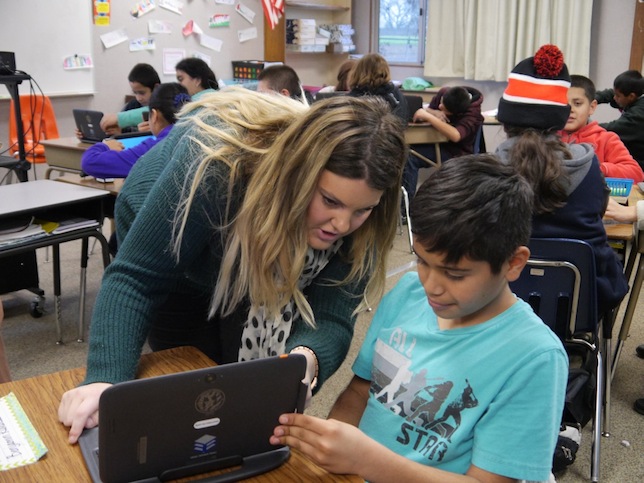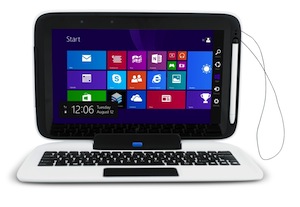1-to-1 Computing
Extra Torque at Manteca Unified
This 1-to-1 program set itself apart from the norm by taking advantage of every trick it could think of to expand and exploit.
- By Dian Schaffhauser
- 03/18/15
The 1-to-1 project at Manteca Unified School District in the central valley of California might, on the face of it, look like many other similar initiatives. The network needed upgrading, the teachers needed training and student devices needed to be chosen. What sets it apart however, is how the district torqued every aspect of the endeavor to maximize the impact of its efforts.
Leverage the New Infrastructure
A big push for the school board to allocate $30 million to the district for this project was linked to the introduction of state online assessments tied to the Common Core learning standards. The work started with the building of wired and wireless network infrastructure, which took up the bulk of the budget — between $18 million and $19 million. Over five months the district's network supervisor designed, redesigned and tweaked the entire Cisco-based network, which now supports nearly 1,700 wireless access points in the district offices and campuses.
The infrastructure was also sturdy enough to support new additions. (This is where the extra torque comes in.) "Our digital project was about student devices and an infrastructure to put those student devices on," noted Manteca Superintendent Jason Messer. "We capitalized on that opportunity to do things like upgrade our phone system and to make sure our infrastructure was robust enough to start doing video surveillance for student safety as we move forward."
Go Whole-Hog with Teacher Training
By March 2014, teachers were outfitted with their devices: the Microsoft Surface Pro 2, a two-in-one touch device that can be used as a laptop or as a tablet. Before a teacher could carry the computer away he or she attended three hours of staff development time, which was initially developed and delivered by a Microsoft education expert. By October and November almost every teacher had gone through that. In addition, teachers are required to get an additional nine hours of development training this year, which could come in multiple forms — online or in-person. But that's all standard.
What isn't standard is what comes next.
First, the district introduced "Cup O Joe" carts, which are rolled out to each school once a week. "You get a free cup of coffee and a half an hour of collaboration time," explained Messer. "We train two teachers at every school we call 'tech champions,' and those tech champions are just there to facilitate the collaboration and the learning for the teachers."

Second, Manteca also hosted its first ever "Educator Conference." School was closed for an in-service day on a Monday in February and one of Manteca's high schools served as the setting for half a dozen keynoters, 67 15- to 45-minute breakout sessions, an expo hall, food and prizes for all educators. An on-site collaboration space allowed participants to earn credit by sharing with each other and watching district-made videos about how to implement various activities in the classroom.
Third, nearly every Monday night Manteca teachers get online to join the district Twitter chat at #ptbmtechchat ("proud to be Manteca Unified..."). Traffic was fairly slow until the district began offering credit for participation. Now "Teachers love the Twitter feeds," said Victoria Brunn, director of Community Outreach and Innovative Programs. Each week, the group tries to focus on a different topic, and frequently, guests are invited from tech companies or other sources to share advice.
During a recent chat, the topic was how parent communications change, Brunn noted. "Folks started to see, 'Wait a minute. Now I can set up a content library in my OneNote notebook on the device and parents can simply look at it and engage with me right there without pieces of paper getting shoved into the bottoms of backpacks.' It's important for us to be looking at all the ways that this kind of a project impacts everything, including communication."
Device Economy Takes All Forms
Although Chromebooks are the current preference for a number of district 1-to-1 programs, that isn't the direction Manteca chose to go. Said Messer, the district considered Chromebooks, but there were too many quirks for users when they were offline and he was concerned about their durability. "I was talking to other districts [that] brought up a very high failure rate."
What the Google Chrome-powered devices did offer was affordability. But Manteca found economy in another area: software. As a Microsoft enterprise, Messer pointed out, "Any of our kids can get access to any Microsoft product that we have access to as the district. The platform wasn't going to cost us more money."
During a visit to Intel a district task force was shown a prototype of a device that fit their shopping criteria. "We basically said, 'We want that. We want a purpose-built device that gives our students all of the tools that I have as a superintendent. Now how can we afford that and is there a manufacturer that's going to do it?'"
A few weeks later Panasonic flew out and met with the district, promising a price point around $500, "depending on what features we put in."
 The 3E is a 2-in-1 touch laptop with a tablet display that can be flipped or detached from the keyboard, student-grade durability and special devices, such as a built-in magnifying lens that turns the camera into a microscope and a temperature probe for lab experiments. The unit includes a stylus that will soon be switched out for a replacement stylus that works with "digital inking" to capture handwriting.
The 3E is a 2-in-1 touch laptop with a tablet display that can be flipped or detached from the keyboard, student-grade durability and special devices, such as a built-in magnifying lens that turns the camera into a microscope and a temperature probe for lab experiments. The unit includes a stylus that will soon be switched out for a replacement stylus that works with "digital inking" to capture handwriting.
It's probably the pedagogical possibilities of digital ink that really sold Messer personally on the Panasonic solution. "When we are writing, we have to summarize. We have to continue to cognate, because we cannot write fast enough to capture the whole story," he explained. "In addition when we are writing, we can capture more in our summary of the story than just auditory. We can capture visual, we can capture kinesthetic — by pressing harder, by pressing lighter.
Stay on Top of Tech Problems
The school adopted Intel's Classroom Management system, which gives the teacher the ability to view what each student is doing, turn off devices and send all students to specific Web sites. "Students pretty quickly figured out how to get around that by either turning their device off and back on — the first game they played — or jumping on our guest network," said Messer. The IT department shut them out of the guest network, but the chase continues.
To stay on top of challenges of having 23,180 new student devices and 1,217 teacher devices on its many campus sites, the district hired 23 new IT professionals. While it has a technician assigned at every site (two per high school), when a student or teacher has a problem, he or she can call or email a help desk system for resolution. Most of those trouble tickets are tackled by a technician at the district offices. When the problem can't be handled remotely, the on-site technician is deployed. According to Messer, the student receives 15 minutes of attention. If that doesn't resolve the problem, "the computer is re-imaged."
All users are learning, he added, to back up their work to their one-terabyte Microsoft OneDrive accounts.
While the superintendent said he can give all kinds of examples of how the new technology is engaging students across the district, the pains to which Manteca has gone to take advantage of its 1-to-1 program really hit home for Messer on a recent visit to a local Starbucks. "People were all sitting at tables. There were business people [and] college students there. And the third table in was a Panasonic 3E and one of our high school students. For me this is what it was about. It was about us giving students access to prepare for their future, and it was about us equalizing that access for all of our students."